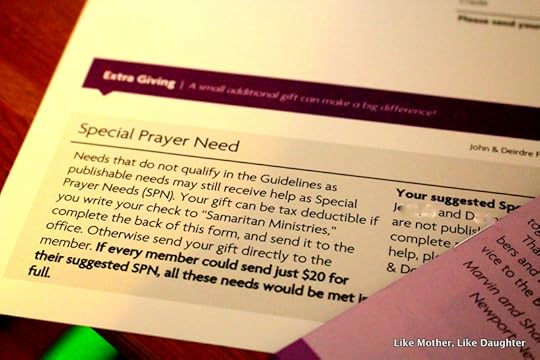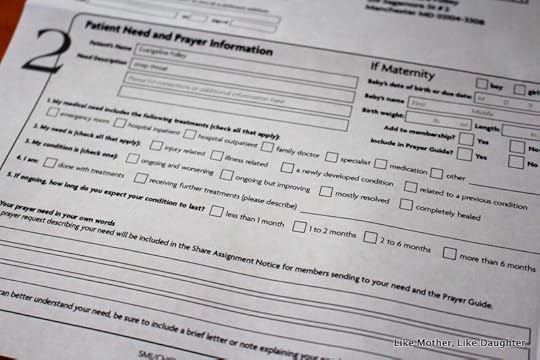Why We Love Being Medically Uninsured: Part 2
Yesterday I told you about why we love Samaritan (read that post here if you missed it!). Today I’ll tell you (as explicitly as I can) how it works.
Monthly Share
Each month, around the 5th, we receive our packet from Samaritan Ministries. The packet consists primarily of the Christian HealthCare Newsletter (their publication; see more below); the monthly prayer guide (includes a daily intention for various members of Samaritan, so we can keep each other in prayer); and a sheet personalized just for us telling us to whom we have been assigned that month, as well as information about Special Prayer Needs (see below).
Let’s say that this month, we’ve been assigned to send our monthly share to Mr. Joe Smith who underwent heart surgery. I write out my check to my assigned Mr. Smith, write a note to him and his family, and send it all along before the 15th of the month. I know that it is going to pay his doctor or hospital bill – simple enough.
I hang the prayer guide on our fridge and make note, as a reminder, that we should be praying for Mr. Smith this month – for his full recovery and the future health of his heart, etc.
The amount that we pay is the standard rate assigned to families with two parents. (See here about the straightforward rates.)
Special Prayer Need
On that same sheet where I read about Mr. Joe Smith, I also received an optional assignment for a “Special Prayer Need” (SPN): a member suffered something that they couldn’t submit to Samaritan as a Need because it didn’t meet the Samaritan Guidelines, or because it was a pre-existing condition, or for some other reason. But Samaritan still wants to enable us to help them out. Let’s say that this month my SPN suggestion is for Miss Jane Brown, who had major dental work (dental is not covered by Samaritan). If the other members and I all send along a small amount (usually $15 or $20 is suggested), her need will be met.
So I send that along as well. I go ahead and budget that in for our monthly expenses, as I see it as a concrete way to do a little charity each month and partake in the broader good work of Samaritan, and I hope that others would ‘do unto us’ if/when we’re ever in this position.
[It’s worth noting that, as I understand it, even members who enter Samaritan with pre-existing conditions (that are technically not covered) or other issues frequently enjoy coverage just through the generosity of members, thanks to the SPN program.]
The back of the sheet contains information about other members who also have SPNs, so that I can also send notes and/or financial help to anyone else if I am so moved.
~~
So that’s all for the month-to-month business. What about when we need to be on the receiving end? I have actually been wanting to write about Samaritan for a long time, but I thought that I should wait until I had experienced the receiving end of it before I gave it the hard sell. Here’s an example with our experience of having our “Need” submitted to the member network:
The medical incident occurs
Finnabee broke her leg. A fluke accident, a small wound (hairline fracture), and she’s all healed now.
We brought her to the Urgent Care center. She was treated there – including seeing the radiologist for x-rays – and then later at the orthopedist. She went to the orthopedist for a follow-up to have her cast removed. That’s a total of 3 separate visits related to this “Need.”
Thank God, we received excellent care. But, like all things in our lovely American medical system, that care involved lots of charges and bills and, ultimately cost close to $1400.
Gather the bills
I’m still in the process of submitting this Need, because, as you are probably aware, the medical machine moves very slowly. No one has come knocking or threatening debt-collection agencies; in fact, I had to hound the hospital to get them to send me the bills for this incident! And, with the payment plan that I have in place, it is a manageable flow of money; we haven’t been slammed with any one big bill at any time.
Negotiate Discounts/Pay Bills/Set up Payment Plan
For each bill, I have requested a discount. The folks at Samaritan actually provide helpful information about negotiating, which makes the process easier. (It’s usually as simple as, “I’m prepared to pay this bill/set up a payment plan, but I’m wondering if you offer a discount to uninsured/cash-pay patients?” or “If I can pay X amount of this bill now, could you reduce the total by 30%?”) The final cost of this incident is now reduced by $470.50. That’s $470.50 less that the whole Samaritan family has to foot – any discount that I can acquire is a win for all of us.
Here’s the big thing, though: remember how I said that the first $300 of any incident is on me? Well, it’s also true that any amount that I can negotiate down from the total bill goes toward that initial $300.
That means that, if I get a discount for $150 off of the total bill, I will only end up paying $150 in the end. In the case of Finnabee’s broken leg, since the total discounts added up to $470.50, I actually won’t end up paying anything for this incident. That is to say, I will pay the bills now but will be reimbursed in full by fellow Samaritan members.
That is why, as I mentioned, we didn’t end up paying anything for my maternity care with Peabodee (including prenatal care, birth, and post-partum care): the total discounts were over $300 when all was added up and accounted for.
Request a Need Processing Packet and Fill the Need Processing Form
As soon as something happens that I know will constitute a Need (or even if I’m not sure), I can call the Samaritan offices to discuss and request a Need Processing Packet. I receive it in the mail after about a week (the most recent one I requested came in four days!). I fill out the forms with the information about the incident.
Then I consolidate my bills, label each one, make a copy of each one, and include them – they need the originals so that I am providing proper proof of everything that has happened. I also write a note, if necessary, explaining the incident and any anomalies about the bills.
Finally, we bring the form to be signed by our parish priest. Every Samaritan member has to be answerable to their church leader, who witnesses to them being active, church-going Christians who adhere to the behaviors required by Samaritan Ministry guidelines.
Submit the Need to be Published
Once I organize the packet and send it in, they will receive and process it and let me know if there are any issues. Once it’s squared away on their end, they will “publish” it – that is, they assign our need to other members for their monthly shares. We know when that happens because the kind notes and checks start rolling in from people we’ve never met, but who we now know are praying for us!
If it turns out that something related to the same incident arises or another bill comes in, we can just get in touch with Samaritan again to submit a “Need add-on” form, and take it from there.
Keep Track Using the Checklist
When the checks start arriving, we log on to our online Samaritan membership account and access our “Checklist.” We make note of every check we receive from the members who were assigned to us, and we can see how many more we are expecting. So, while no member is legally required to send money to us, there is accountability here. If some members drop off on their giving, they won’t be eligible to have their Needs published – in effect, they will fail themselves out of the membership.
That is the whole process from start to finish! I’ve tried to spell it out in detail and I hope it makes sense, but feel free to ask me other questions in the comments and I’ll do my best!
Some other thoughts about belonging to Samaritan Ministries:
It’s a great deal for young people, especially families. It strikes me that we are getting the best end of this, being a young family who hope to grow. There is one fixed price for any family, so we will continue to pay the same monthly share whether we have the two kids or, ultimately, eight. Whereas insurance plans would charge us based on our number of dependents, Samaritan is looking like a great long-term deal for us.
I think the best time to jump on this would be if you’re a family and you’re basically in good health (that is, don’t have to worry about pre-existing conditions).
Any member household with a head-of-household under age 25 receives a discount, including singletons.
I love the newsletter. I have learned a lot from reading the Christian HealthCare Newsletter that’s included in our packet each month. There’s always interesting medical information from an independent (as opposed to insurance-company-beholden-mainstream) perspective, as well as inspiring stories from other members and helpful social commentary. Despite the fact that I do not always agree with the theology presented in some of the articles, I think that it is, overall, a helpful source of formation and information. It’s another factor in making me a smarter, more engaged health care customer.
I would actually encourage anyone who’s interested in Samaritan, but not planning on/prepared for joining, to subscribe to the Newsletter or just keep up online.
There is some work involved. There is a certain amount of paperwork to be handled and, as of now, it is mostly on physical paper (I know there are some plans to shift more of the process online, but I don’t know details). Sometimes this is a little cumbersome (especially when you don’t have a copier at home!).
There is a certain amount of keeping track – I’m learning that I might want to have my own system of, for instance, keeping an excel spreadsheet and maybe a separate file folder for every “Need.” I do have to stay on top of things to keep it all organized. If I had a lot of kids who were all in and out of the ER, I know I would have to establish a very efficient filing system and stay well on top of it.
That being said, I know that it can be a lot of work, including paperwork, to keep on top of an insurance plan as well, so I don’t think that that factor alone should deter anyone with normal circumstances.
Samaritan looks out for its members. There’s always word in the Newsletter about the latest angle that Samaritan is working on it help its members get good health care. So, for instance, while the ministry doesn’t cover dental or eye care, they do offer resources for seeking affordable options in those areas, and there is a program for getting better deals on medical prescriptions as well.
Why don’t you do a Catholic one? Since this is the one that was recommended to us by a close (Catholic) friend, this is the one that we joined. The Artist and I have discussed whether we should switch, and we honestly do not see a reason to do so at this time. We are on board with this mission and we actually enjoy that it’s an area of life in which we can share whole-heartedly with other Christians.
Are pre-existing conditions prohibitive? Samaritan accepts all members who are willing to agree to the requirements, but those with pre-existing conditions won’t be able to submit Needs relating to those conditions. I believe that this is due to the fact that Samaritan has to mitigate risk involved potential exploitation of the membership, as well as simple financial limitations. (See the guidelines for the in-depth discussion of pre-existing conditions. There is a 1-5 year symptom-free period after which Needs can be shared.)
Some individuals or families who have pre-existing conditions that are serious and/or ongoing might find that Samaritan isn’t practical or affordable. Again, many of those needs can be covered via the SPN program, but there is no guarantee about that and I haven’t been on the receiving end of the SPN so I can’t share a personal experience on that. I do wonder if this is an area where Samaritan would like to grow (in general, the group is very pro-growth); perhaps in the future, there will be more ability to take on people who have these needs.
Is it for everyone? I don’t know everyone’s situation, so I’m certain not going to say everyone ought to do this! As with so many things, it depends on your/your family’s needs, circumstances, and desires.
Having read dozens of testimonies in the Newsletter and having had my own totally positive experience, I can only say that I think it would be worth learning about, especially if you do not already have a good insurance plan provided through your work (and perhaps even if you do!). I will repeat that it is huge to know that your bills are all going to a good place each month and you are not in any way cooperating with nor enabling morally objectionable “medicine.”
Again, I’m no expert in this area, but I can say that it has been good for us financially, emotionally, and spiritually.
Are you a member of a cost-sharing ministry? Is this something you are interested in?
~~
Full Disclosure: I am not receiving any kind of payment nor compensation from Samaritan Ministries or any associated party. I’m just a true believer in this model and would love to see it spread! There are other cost-sharing ministries out there, so I’d say check them all out and see which one works best for you!
That being said, if you do decide to look into Samaritan and end up choosing to become a member, we would be very appreciative if you mention our names (John and Deirdre Folley) as referring members when it comes time to fill out your start-up forms: we would receive a credit on our monthly share that would be a great help to us, especially while The Artist is in training!
The post Why We Love Being Medically Uninsured: Part 2 appeared first on Like Mother Like Daughter.








